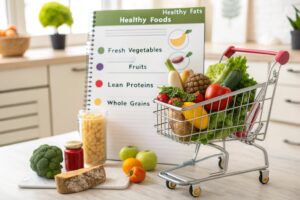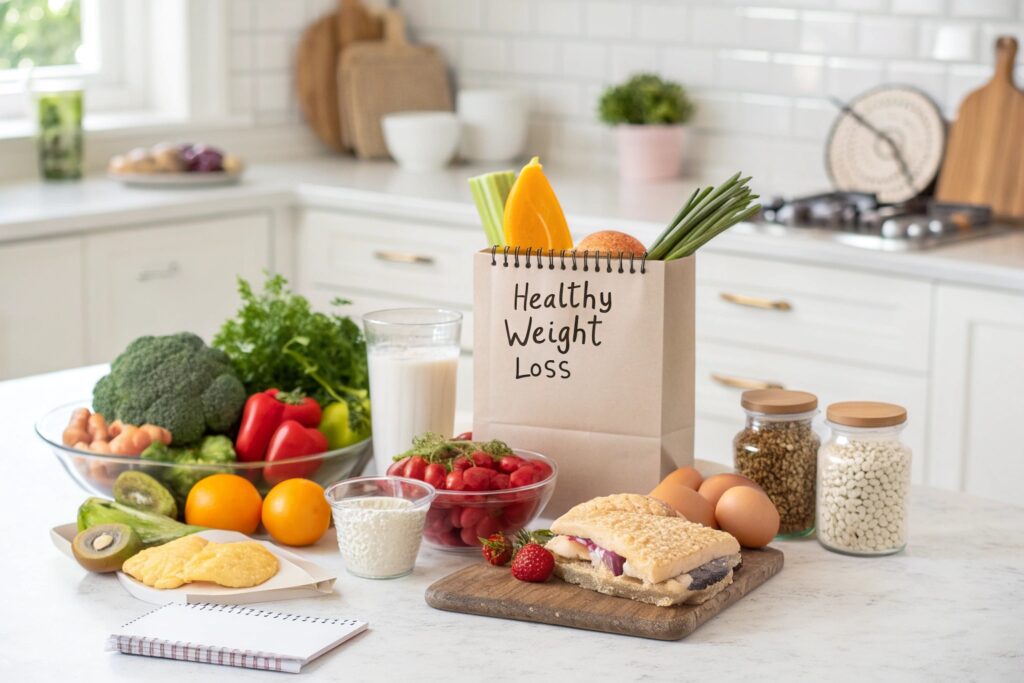Introduction
A Beginner’s Shopping List for Healthy Weight Loss-Embarking on a weight‑loss journey can feel overwhelming, especially when you step into the grocery aisles without a clear plan. A Beginner’s Shopping List for Healthy Weight Loss serves as your roadmap, guiding you toward nutrient‑dense foods that keep you full, fuel your body, and support steady, sustainable fat loss. In this comprehensive guide, we’ll break down the science behind smart grocery choices, provide ready‑to‑use categories, and share expert‑backed strategies that turn a simple shopping trip into the first step of a lasting, healthier lifestyle.
Whether you’re a busy professional, a college student, or a stay‑at‑home parent, the principles outlined here apply to any budget, kitchen skill level, or dietary preference. By the end of this article you’ll have a fully stocked pantry and fridge that empower you to create balanced meals, control portions, and stay motivated—without resorting to fad diets or expensive “miracle” products. Let’s dive into the essential foods that make up A Beginner’s Shopping List for Healthy Weight Loss and learn how to shop smarter, eat better, and lose weight healthily.
Section 2: Understanding the Foundations of a Weight‑Loss Grocery List
Before you grab a cart, it’s crucial to understand why certain foods are staples for weight loss. Research from the Harvard T.H. Chan School of Public Health shows that diets rich in protein, fiber, and healthy fats not only reduce calorie intake but also improve satiety hormones like leptin and ghrelin. Protein leverages the thermic effect of food (TEF), meaning your body burns more calories digesting it—up to 30% of the protein’s calories, compared to 5–10% for carbs and fats (Miller et al., 2021). Fiber, on the other hand, slows gastric emptying, keeping you fuller longer and stabilizing blood glucose levels.
Equally important is the concept of nutrient density. A nutrient‑dense food provides a high proportion of vitamins, minerals, and phytonutrients relative to its calorie content. Choosing such foods maximizes nutritional intake while keeping total calories in check. For beginners, focusing on lean proteins, non‑starchy vegetables, whole grains, and healthy fats creates a balanced plate that meets macronutrient goals without feeling restrictive. Remember, the goal isn’t “eat less” but “eat right.”
Section 3: Core Categories to Fill Your Cart – Actionable Advice from Nutrition Experts

1. Lean Proteins – The Building Blocks of Satiety
Protein should be the cornerstone of your weight‑loss grocery list. Aim for 20–30 g of high‑quality protein per meal to trigger muscle protein synthesis and curb cravings. Excellent budget‑friendly options include:
-
- Skinless chicken breast or thighs (≈ 31 g protein per 100 g)
-
- Turkey ground or breast slices
-
- Canned tuna or salmon in water (≈ 25 g protein per 100 g)
-
- Eggs (6 g protein each; versatile for breakfast or dinner)
-
- Greek yogurt (plain, 10–12 g protein per 100 g)
-
- Plant‑based legumes: lentils, chickpeas, black beans (≈ 8–9 g protein per ½ cup cooked)
Registered dietitian Maria Alvarez, MS, RDN recommends pairing each protein source with a fiber‑rich side to balance blood sugar spikes. For example, a serving of grilled chicken with a quinoa‑and‑vegetable medley provides about 450 kcal, 35 g protein, 40 g carbs (mostly complex), and 8 g fiber—ideal for weight loss.
2. Fiber‑Rich Vegetables – Low‑Calorie Volume Fillers
Non‑starchy vegetables are the unsung heroes of a weight‑loss plan. They provide volume, micronutrients, and antioxidants while contributing < 25 kcal per cup. Stock up on:
-
- Leafy greens: spinach, kale, arugula
-
- Cruciferous veg: broccoli, cauliflower, Brussels sprouts
-
- Colorful peppers, zucchini, cucumber, and tomatoes
-
- Root vegetables in moderation: carrots, beets (great for roasting)
Studies published in the American Journal of Clinical Nutrition (2022) found that each additional serving of vegetables per day was associated with a 12% reduction in waist circumference over a 12‑month period. Pre‑wash and pre‑cut these veggies for quick snack‑size portions—this simple prep step removes the “convenience barrier” that often leads to unhealthy snacking.
3. Whole Grains & Starchy Roots – Smart Carbohydrate Choices
Complex carbs supply steady energy and help preserve lean muscle during calorie deficits. Prioritize whole, minimally processed grains:
-
- Brown rice, wild rice, or quinoa (≈ 5 g fiber per cup cooked)
-
- Whole‑wheat pasta or couscous
-
- Oats (steel‑cut or rolled) for breakfast or baking
-
- Sweet potatoes (rich in beta‑carotene and resistant starch)
When comparing refined white rice to brown rice, a 2019 meta‑analysis reported a 0.6 kg greater weight loss over six months for participants who chose the whole‑grain option, likely due to higher satiety and lower glycemic impact.
Section 4: Comparing Healthy Alternatives – Benefits and Potential Challenges
Choosing the right foods isn’t just about nutrients; it’s also about suitability for your lifestyle, taste preferences, and budget. Let’s compare three common categories to help you decide which items belong on A Beginner’s Shopping List for Healthy Weight Loss:
Low‑Fat Dairy vs. Plant‑Based Alternatives
Low‑fat Greek yogurt delivers 10 g protein per 100 g with only 0.5 g fat, supporting muscle maintenance and calcium intake. Plant‑based yogurts (almond, coconut) often contain added sugars and lower protein unless fortified. However, for those with lactose intolerance, fortified soy yogurt provides comparable protein (≈ 6 g) and is enriched with vitamin D and calcium. The trade‑off: watch for “non‑fat” labels that hide sugar.
Fresh Produce vs. Frozen Produce
Fresh vegetables are ideal for salads and quick stir‑fries, but they can spoil quickly, leading to waste—a hidden calorie cost. Frozen vegetables are flash‑frozen at peak ripeness, preserving nutrients (vitamin C retention > 80%). A 2020 USDA study found no significant difference in nutritional content between fresh and frozen broccoli. Choose frozen for convenience and cost‑efficiency, especially for out‑of‑season items.
Lean Meat vs. Plant‑Based Protein Sources
Lean meat (chicken breast, turkey) offers high‑quality complete protein with minimal carbs. Plant proteins (tofu, tempeh, legumes) deliver fiber and phytonutrients but may require combining multiple sources to reach a complete amino acid profile. For beginners, a mix works best: a few days a week of fish or poultry paired with plant‑based meals ensures variety and reduces saturated fat intake.
Each alternative carries potential challenges—budget constraints for fresh organic produce, taste adaptation for plant proteins, or cooking time for whole grains. Address these by batch‑cooking, using spices, and leveraging multi‑functional ingredients that serve multiple meals.
Section 5: Practical Tools & Step‑by‑Step Guide to Build Your Shopping List
Turning knowledge into action requires an organized system. Below is a printable, three‑day meal‑prep framework that uses the items highlighted above. Adjust portions based on your individual caloric needs (most adults aiming for weight loss consume 1,200‑1,800 kcal/day).
Step 1: Inventory & Meal Planning
Before you shop, conduct a pantry audit. List existing staples (olive oil, spices, canned beans) and note what’s missing. Use a free app like MyFitnessPal or Paprika Recipe Manager to log meals and calculate macros. For beginners, a simple spreadsheet with columns for protein, carbs, fat, and fiber works well.
Step 2: Create Category‑Based List
Structure your list by sections to speed up store navigation:
Proteins: chicken breast, eggs, canned tuna, Greek yogurt, lentils.
Vegetables: spinach (fresh or frozen), broccoli florets, bell peppers, carrots.
Whole Grains: brown rice, quinoa, rolled oats.
Healthy Fats: extra‑virgin olive oil, avocado, raw almonds.
Seasonings: garlic, ginger, turmeric, low‑sodium soy sauce, lemon.
Printing this list and using a “check‑off” column reduces impulse purchases—a common barrier identified in a 2021 behavioral economics study on grocery shopping.
Step 3: Batch‑Cook & Store
Allocate 1‑2 hours on Sunday to prepare core ingredients:
-
- Cook a large batch of quinoa (2 cups dry) – store in airtight containers.
-
- Roast a tray of mixed vegetables with olive oil and herbs (approx. 1 kg).
-
- Grill or bake 1.5 kg of chicken breast; portion into 150 g servings.
-
- Boil a pot of lentils (1 cup dry) for salads and soups.
These components can be mixed‑and‑matched throughout the week: a quinoa‑veggie bowl with grilled chicken for lunch, a lentil soup with a side of roasted veg for dinner, and Greek yogurt with berries for breakfast. By having pre‑cooked staples, you eliminate the “what’s for dinner?” dilemma, thereby sticking to your weight‑loss plan.
Section 6: Frequently Asked Questions, Common Pitfalls, and Next Steps
Q1: How many calories should I aim for each day? The USDA’s Dietary Guidelines suggest a modest deficit of 500 kcal/day for a safe 0.5 kg/week loss. Use a basal metabolic rate (BMR) calculator and factor in activity level to set a personalized target.
Q2: Can I still enjoy treats? Yes—moderation is key. Incorporate a “flexible snack” like a small square of dark chocolate (≥ 70 % cacao) or a fruit‑based dessert. Keeping treats on the list prevents binge‑eating later.
Q3: What if I have dietary restrictions? Replace animal proteins with legumes, tempeh, or fortified plant milks. For gluten‑intolerance, switch quinoa, brown rice, and certified gluten‑free oats for wheat‑based grains. Always read labels for hidden sources of allergens.
**Common Pitfalls** – Many beginners abandon their plan due to “meal monotony” or “time constraints.” Combat this by rotating herbs, spices, and cooking methods (steaming, grilling, stir‑frying). Another frequent issue is “portion distortion.” Use a kitchen scale or the palm‑method (protein ≈ palm size, carbs ≈ fist, fats ≈ thumb) to keep servings accurate.
**Next Steps** – Now that you have A Beginner’s Shopping List for Healthy Weight Loss and a practical prep system, commit to a 4‑week trial. Track progress with weekly weigh‑ins and body measurements. Celebrate non‑scale victories—more energy, better sleep, tighter clothes. Share your experience in the comments below or on social media with #WeightLossGroceryGuide. If you found this guide helpful, explore our related posts on “Meal‑Prep Hacks for Busy Professionals” and “Understanding Macronutrient Ratios for Fat Loss.” Together, we can turn healthy shopping into lasting success!



